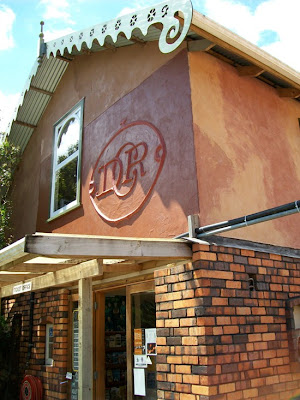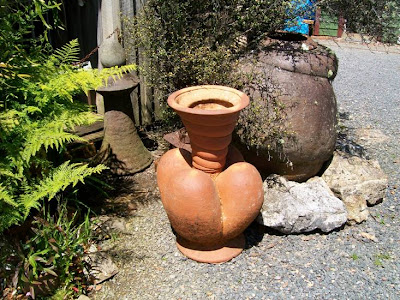More from the WAHS excursion. We had 20 minutes stopover in Coromandel township yesterday on the way back home to Auckland. Not a long time, but I did a quick tour of the main drag for the following shots. Oh, above is a quick shot of the western coast of the peninsula as we sped past in the bus. Extremely cool and beautiful drive along that coast. If you've not seen it before, I highly recommend it.
The local loos.
Lovely mural on both front and side walls (may be at the back too, but I was in a bit of a rush to take in as much of Kapanga Street as possible). This was a Coromandel area school mural project, 2007-2008, sponsored by Driving Creek Potteries and the local district council.
I reckon they've moved the loos during the township's history, though. Here's this archway, further down the street ...
... with a memorial stone to Samuel James who gifted "this rest room" to the people of Coromandel in 1929.

Mr. James was born in London, and served his apprenticeship to the building trade in that city. In 1870 he came to New Zealand by the ship “City of Auckland,” Captain Ashby. When he landed in Auckland, the building trade was very quiet, and Mr. James set up as a builder and wheelwright at Newmarket. Then when the discovery of gold attracted the attention of the public to Coromandel, Mr. James joined in the “rush” thitherwards, and experienced the usual “ups and downs” of a goldfields' life. He carried out a large amount of prospecting at the Tiki, where he spent four consecutive years, and then followed various callings—sometimes at his trade of carpentering and sometimes at mining—until he started the present concern in 1889. By dint of hard work and assiduous attention to his business, he has succeeded in working up a large connection, and is now looked upon as one of the most successful men in the district. He has been most successful in his mining ventures, being a large property holder in and around Coromandel. Mr. James was married in the Colony. His private residence is situated in Rings Road, Coromandel, between the upper and lower townships. In church matters, he is a trustee of the Coromandel Wesleyan Church. Mr. James is a member of the Coromandel County Council and of the Hospital and Charitable Aid Board, and a Justice of the Peace.

Coromandel prides itself on its heritage look. It's a tourist attraction, as much as the links to the goldmining and timber milling past, and the Driving Creek Railway attraction up the road. Some buildings look original or near to it. Some though (I'll point them out later as I go) aren't or are likely not to be.
I think the wringer-washer on the laundromat verandah roof is a hoot.
The Star and Garter seems to be a latter version, judging from the 1902 photo below from the Cyclopedia.
There were a few of these in the township. Help from readers as to what they are would be appreciated.
Above is an example of "I don't quite think these are original". If they are, they've been altered and added to.
A recognised heritage building, the Assay House Tearooms.
Finishing this post up with a mural, the last shot I took for the day, on the side of one of the local dairies.




































.jpg)







































